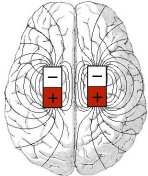Solving the “Hard Problem”: Consciousness as an Intrinsic Property of Magnetic Fields.

Our brains contain magnetic crystals; 5 million of them per gram. Todd Murphy proposes that the magnetic field they create in our brains, with their many positive and negative poles, form the physical basis of consciousness; the physics of our mysterious awareness.
The two poles of a simple magnetic field offer the basis for feedback between the perceiver and the perceived, an essential feature of consciousness.
Each electrical signal running between brain cells reverberates throughout the brain’s very complicated internal magnetic fields, allowing us to be aware of them. Every input to the brain creates electrical activity in the brain, and these are imposed, however briefly, on the brain’s internal magnetic field. Neuroscientist Todd Murphy suggests that our subjective experiences interface with the world around us when the neural electrical activity it creates integrates with the brain’s internal magnetic field. Moreover, patterns of activity in the brain’s magnetic field can influence electrical firing in brain cells, completing their reciprocal relationship.
YouTube video presentation on this solution to the “Hard Problem“. (52 minutes).

Rather than invoking a complex theory or resting on intricate mathematics, Murphy proposes that the 19th century formulas, called Maxwell’s Equations, which describe the relationship between electrical currents (including axons in the brain) and magnetic fields, are enough to describe the physical basis of consciousnesses.
The brain’s magnetite crystals, arranged in chains called magnetosomes, are found in many species, including simple bacteria that use them for up/down orientation. Murphy even suggests that our nervous systems may have first evolved to conform with the physics of magnetic fields, evolving brain tissue to facilitate their information processing and exchange.
Noting that science can only examine consciousness in biological organisms, Murphy alludes to the fact that magnetic fields are propagated at a significant fraction of the speed of light (a bit less than that in a ‘wet’ medium). This means that a single magnetic signal can resonate throughout the brain in vanishingly small periods of time. This makes it the fastest mode of communication available in the brain, very important for organisms needing to respond to threats or opportunities. Consciousness, Murphy asserts, is an evolutionary adaptation that contributes to the survival of conscious species, and organisms that take more time to respond to their own perceptions are more likely to be eaten by predators, or to lose food sources, than those that respond to them more quickly .
Murphy’s theory addresses the dualism debate (whether or not consciousness is a material process) by pointing out that magnetic fields are neither matter nor energy (in the language of physics, they’re forces), so whether consciousness is material or not depends on the definition for ‘matter’ in this case. If ‘matter’ includes fundamental forces, then consciousness is material. If it only applies to matter itself (as we commonly experience it), then consciousness is not material.
Murphy’s paper (link below) points out that no magnetic field can ever be ‘blocked’ or ‘shielded’, so all consciousness is both local (depending on a nervous system), and “non-local,” because the magnetic signals (reflecting electrical signals) can be ‘broadcast’ to other brains. The fields may be very faint by the time they reach another nearby brain, but Murphy suggests that the information content is more important than the field strength. A weak magnetic field with meaningful signals will be received more readily than ‘garbage data’ borne on a strong magnetic field.
Todd Murphy, associated with the Laurentian University Behavioral Neurosciences Program for decades, also suggests a few possible experiments that would support his theory, but proving it decisively will not be easy. The very definition for the word consciousness presents a problem, because all definitions refer to it’s synonyms (like ‘awareness,’ or ‘subjective’), making them “tautological”. In addition, consciousness is an inherently subjective experience; we can’t share our subjective experiences with others, or directly know what they perceive. (Is ‘red’ the same for you as it is for me, or are we only agreeing that the word ‘red’ is right for, say, an apple?)
Assuming it gains attention and stands the test of time, Murphy’s theory will have solved the “hard problem” of consciousness without reference to any metaphysical, philosophical or religious concepts, instead relying only on neuroscience and basic physics.
A) Magnetic fields are ‘conscious’ by virtue of their many input/output avenues, which allow them to function as feedback mechanisms.
B) The brain’s magnetic fields ‘pick up,’ or resonate with, information from the brain’s electrical activity, making us conscious of our own thoughts, feeling, and perceptions.
C) The magnetic fields also impose their patterns of information on the brain’s electrical system, influencing neuronal electrical activity.
The “hard problem” has been called the most difficult challenge facing science today, but as with many riddles, it looks easy once it’s been solved.
Todd Murphy’s full paper:
https://jcer.com/index.php/jcj/article/view/835/850
Murphy, T., “Solving the ‘Hard Problem’: Consciousness as an Intrinsic Property of Magnetic Fields” Journal of Consciousness Exploration & Research| November 2019 | Volume 10 | Issue 8 | pp. 646-659
